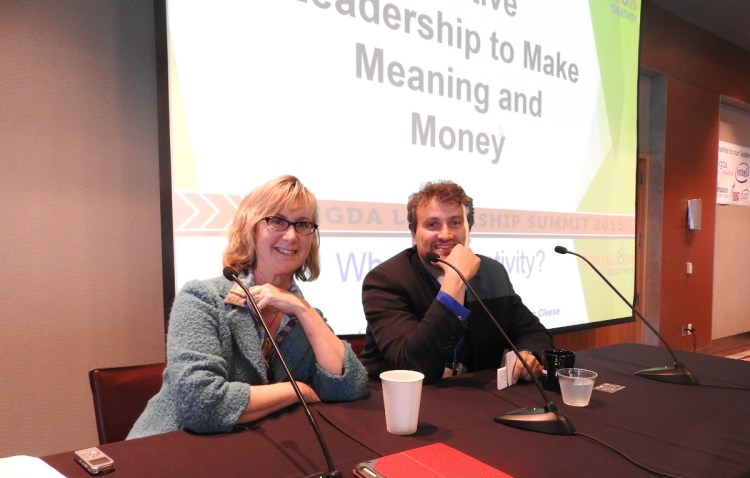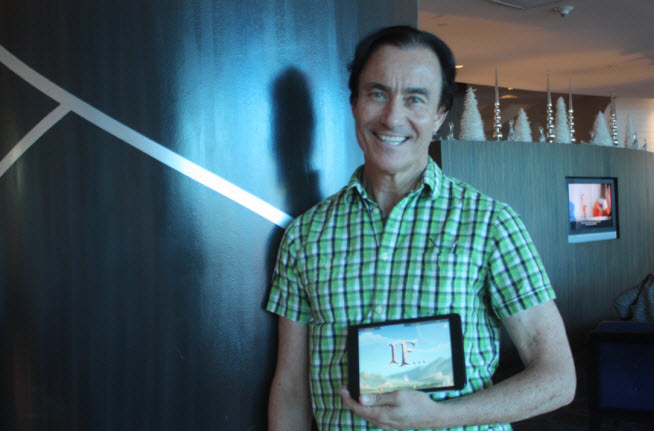GamesBeat: How does this unconscious bias link back into creativity?
Gaiser: Leading with creative intelligence and being supported by intellectual intelligence – the opposite of what we’re doing right now – fosters that open mind and open heart. That becomes the norm. The values of creativity are curiosity, kindness, open mind, open heart, resourcefulness, the courage to take risks.
Behavior is mimicked, too. I remember working at Microsoft for a very short time, a long time ago. They didn’t value those things at that time. I felt so unwelcome, because my skills weren’t being valued. It’s a step, a very big step, at eradicating unconscious bias. When someone leads like that – a lot of you raised your hands – there’s such a positive energy that it becomes contagious.
At Her Interactive, we co-created that culture. The positivity was so palpable that when people came, they would note it. When we had employees, a few of them, who weren’t the right fit—It’s as if everyone was so protective of this positive culture that it was obvious that person couldn’t operate within it. Behavior is contagious.
It also takes work on all of our parts to become more self-aware. The next time I dismiss someone, I’m going to think more about it, because I didn’t think I did it until I took part in this exercise. All of us need to change. It’s not just the leaders in higher positions. As leaders – and we all are – we can help guide them to behave more positively through the way we behave ourselves.
Bernstein: To Dean’s point, companies like Intel and Microsoft are certainly aware that this is an important issue they need to address. At least superficially, at this point – though there’s no big sea change yet – there’s been interest.
One thing about why diversity matters to creativity. What is creativity if not a collection of stories? What is my story? I was born in St. Petersburg, Russia back when it was the Soviet Union. I have a whole set of stories that is mine. That’s the story I can tell. Wouldn’t it be great if I could tap into my employees and their diverse backgrounds and their stories as well? From all those stories comes emotion. From that emotion comes creativity. From that creativity comes innovation. From that innovation comes revolutionary products, and thereby revolutionary revenue.
The point is, how can you tap into that diversity? Tell those stories. Give people the freedom that they require to be able to tell those stories in a non-threatening manner, in a way that lets them feel they have ownership of those stories and whatever product they’re building that’s going to be revolutionary.
Gaiser: That’s only going to happen if we have diverse leadership. You can’t tell my story. You can’t have my perspective. At Her Interactive, when we began with our first Nancy Drew game, the publishers told us, “We won’t let you into retail because girls are computer-phobic.” That’s when we realized that these leaders aren’t leading at all. They don’t have the courage to buck the status quo. It was clear that they had limited perspectives. They believed it. They were biased, unconsciously and not. It took a different perspective to create something for a huge population that was totally necessary.
That’s why diverse creators and designers need to be in key positions. The decision-making needs to be theirs, to broaden what we’re seeing. Right now it’s too homogenous. It’s not moving us forward.
Bernstein: I don’t quite agree with you. This is back to my original point. When you start seeing leaders who are not the white guys running these large companies, public companies, they’re still not changing the culture internally. Anyone can change the culture, whether you’re a woman, a man, a minority or not. You can tap into those stories because you realize the value that can be driven from it.
It requires an act of bravery no matter who you are. Tapping into those stories requires a bravery that’s irrelevant to where you come from. But it has to be there. Maybe this is more of a “yes, and” than “no,” but my disagreement is that you don’t have to have diverse leadership to actually make changes in your company to be diverse.
The jury is still out on a lot of folks that are the new diverse leaders out there. They may be walking the same road that’s been set up for them, or they may transform it with their leadership. But it comes down to them, to their ability to make changes within their organizations.
Gaiser: It’s harder for corporations to make this shift. The system is in place. It’s very structured. Microsoft is on that trail, and Intel as well. They’re doing it piece by piece and bringing in the people to do it. But the indies are leading the way. It’s exciting, because corporations can learn a lot from the type of behavior in leading for the collective. The original games, the ground-breaking games—Not all of them, of course, but many of them are coming from the indies. And indies don’t need big corporations to get financing now.
Bernstein: My old boss was Trip Hawkins, the founder of EA. He bought Digital Chocolate, which bought Sandlot in 2011. He worked for Steve Jobs back in the late ‘70s. Trip is a creative guy, but he’s more of a button-down type. He was a marketing guy at Apple, a business guy, back when they were just a handful of employees. Steve walked into his office and asked Trip, “So, you’ve never done LSD, have you?” Trip said, “No.” Steve just turns around and walks away.
Trip’s wondering what just happened. Is this another way Steve is trying to get into his head? But the point he was trying to make, if you’re tapping into some other reality—Steve Jobs, if you know the biography, he was all about that. Sometimes a bit too egomaniacal about that. But the point is, breaking open your mind and exposing yourself to a larger reality, whether or not you need drugs for that, that’s what he was trying to draw out of the folks who were working for him.
Then there’s the other side, being so creative that you can’t do anything. We’re not talking about that creativity. This is where leadership is important, because leadership is targeting—If you open this up, it’s like an oil well, a gusher. As leaders, we’re the ones responsible for fostering the best ideas and making them into real products. But unless we dig, we’re not going to find the well.
Question: We’ve heard a lot about creativity and what’s wrong with this industry. I sense a bit of a fix-it mentality. Here are the problems and here’s a solution. My question is, are there any companies doing this out there? Can we point to anyone and say, “We need more of that in the world?” And where do we go from here? We’ve talked about creativity and diversity in leadership, but what’s the next step?
Bernstein: I used to look at Popcap back in the day as a company that was very successful on its own merits. I modeled Sandlot after what they did. They did their game jams and came up with ideas that seemed ridiculous, but they made money and grew into what they’ve become.
Down the same path, the reason we built Tradewinds was to buck the status quo. We had this great idea. I used to play Tai-Pan when I was a kid. This was back when Bejeweled and match-threes were the most popular thing around. We just wanted to do it, badly.
Back in the day, the problem was that the ecosystem wasn’t very forgiving for new ideas. Part of the conversation is still about fixing those ecosystem problems. If you don’t fix it, there’s going to be a crash and it’ll fix itself. But that’s a separate topic. Certainly you see a lot of creativity on Steam, but it’s still very much relegated to the indies. In order for that level of innovation to express itself again, we need that same level of success from a fully creative company, like a Popcap.




